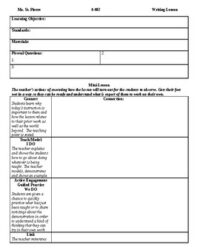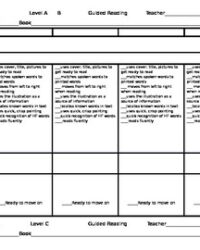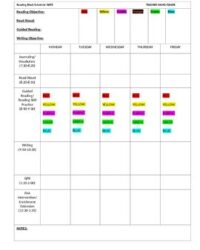If you’re an educator, especially one focused on literacy, chances are you’ve heard of Lucy Calkins and her groundbreaking work in reading and writing workshops. Her approach emphasizes student choice, authentic texts, and a structured yet flexible framework that helps students develop into lifelong readers and writers. Many teachers find immense value in her Units of Study, but translating that comprehensive curriculum into daily, manageable lessons can sometimes feel like a puzzle. That’s where a well-designed lesson plan template becomes an invaluable tool.
A lucy calkins lesson plan template isn’t just about filling in blanks; it’s a strategic framework that helps you align your daily instruction with the rich, research-backed principles of her workshop model. It ensures you hit all the critical components of a balanced literacy lesson, from the concise mini-lesson to active engagement and independent practice, while also providing space for reflection and adaptation. For educators striving to implement the Units of Study with fidelity and effectiveness, having a structured template can bring clarity and confidence to their daily planning.
Deconstructing the Lucy Calkins Lesson Structure
At the heart of the Lucy Calkins workshop model is a predictable, consistent structure that allows students to internalize routines and focus their energy on learning. Understanding these core components is key to developing an effective lesson plan, whether you’re creating your own or adapting an existing one. The structure typically includes a Minilesson, Independent Work Time (often with conferring), a Mid-Workshop Teaching Point, and a Share.
The Minilesson is arguably the most crucial part, designed to be concise and impactful, usually lasting 10-15 minutes. It follows a predictable arc: Connection, Teaching Point, Teach, Active Engagement, and Link. The Connection briefly hooks students and relates the new learning to prior knowledge. The Teaching Point clearly states what students will learn today. The Teach portion demonstrates the new strategy or skill through modeling. Active Engagement provides students with a quick, hands-on opportunity to try out the new learning with a partner or independently. Finally, the Link sends students off to apply the lesson during independent work time.
Following the Minilesson is the Independent Work Time, the longest segment of the workshop. During this time, students apply the strategies learned in the mini-lesson, engaging in authentic reading or writing tasks. This is also when teachers are most active, circulating, observing, and holding individual or small-group conferences. Conferring is powerful, allowing teachers to provide targeted, differentiated instruction based on individual student needs, moving students forward in their literacy journeys.
Mid-Workshop Teaching Points are brief interruptions during independent work time, used to reinforce a concept, troubleshoot a common issue, or introduce a quick, related strategy to the whole class or a small group. This responsive teaching ensures that common pitfalls are addressed in real time. The workshop concludes with the Share, where students come back together to reflect on their learning, share their work, and celebrate successes. This segment deepens understanding and builds a community of learners.
Key Elements to Include in Your Template
When creating or utilizing a template, ensure it provides dedicated sections for each critical phase of the workshop. This not only streamlines your planning but also acts as a checklist, ensuring you don’t overlook any vital component. A comprehensive template fosters consistency and allows for focused reflection on your teaching practices.
Consider including spaces for:
- Date and Unit/Bend of Study
- Connection (what will you connect today’s lesson to?)
- Teaching Point (the clear, concise learning goal)
- Materials Needed (books, charts, mentor texts, etc.)
- Teach (your demonstration and modeling)
- Active Engagement (what will students do to practice?)
- Link (how will you send students off to work?)
- Independent Work Time Notes (potential conferring groups, specific student goals)
- Mid-Workshop Teaching Point (if applicable)
- Share (how will students share their learning?)
- Assessment Notes/Next Steps (brief observations or plans for future lessons)
Maximizing Your Planning with a Lucy Calkins Lesson Plan Template
Using a template isn’t about rigid adherence; it’s about providing a scaffold for your thinking and ensuring that the fundamental principles of the workshop model are always in play. The beauty of the Lucy Calkins Units of Study lies in their flexibility and responsiveness to student needs, and a good template supports this adaptability rather than hindering it. It helps you keep the bigger picture in mind while focusing on the day-to-day nuances of your classroom.
One significant advantage of consistently using a structured template is the way it encourages thoughtful pre-planning. By filling out the sections, you’re prompted to consider not just “what” you will teach, but “how” you will connect with students, “how” they will actively engage, and “how” you will assess their understanding. This forward-thinking approach can dramatically improve the fluidity and effectiveness of your lessons, making you feel more prepared and less rushed.
Furthermore, a well-used template becomes a living document that can inform your long-term planning and reflection. After a lesson, you can quickly jot down notes on what went well, what challenges arose, and what adjustments might be needed for the next day or unit. This continuous cycle of planning, teaching, and reflecting is crucial for professional growth and ensures that your instruction is always evolving to meet the dynamic needs of your students.
Here are some practical tips for leveraging your lesson plan template:
- Review the entire unit or bend before planning daily lessons to understand the progression.
- Personalize the template with your own teaching style and classroom management notes.
- Use it to track student data points or anecdotal notes during independent work time.
- Reflect on each lesson after teaching and make notes for future improvements.
- Share and collaborate with colleagues using a similar template to streamline planning discussions.
Ultimately, integrating a structured approach to your lesson planning, especially one rooted in the principles of a lucy calkins lesson plan template, can transform your teaching practice. It provides the clarity and organization needed to deliver engaging and effective literacy instruction, ensuring that every minute of your workshop counts. This commitment to thoughtful planning empowers you to meet your students where they are, guide them through purposeful learning experiences, and cultivate a classroom where reading and writing flourish.


